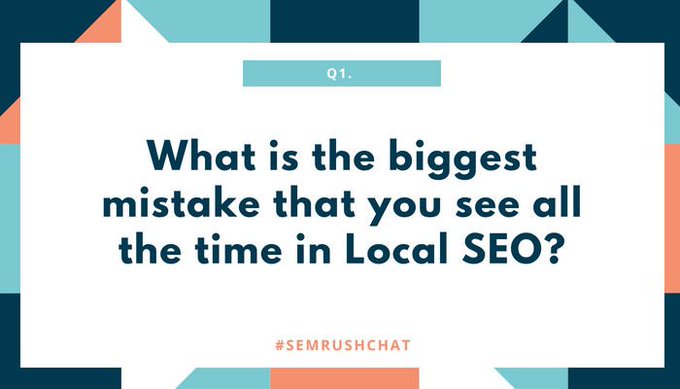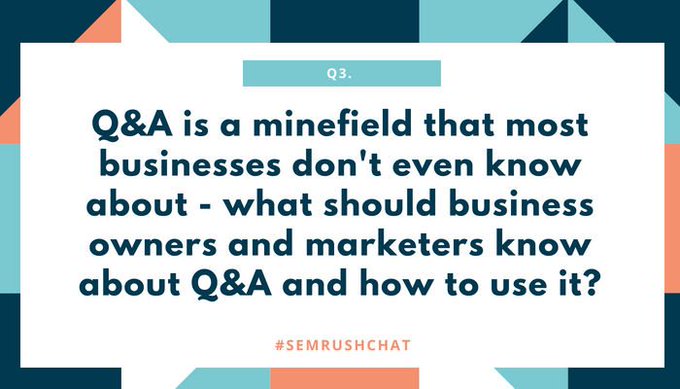82% of smartphone users are turning to search engines to identify local businesses, and this is just one reason why it is essential for businesses to nail their local SEO strategy to improve foot traffic that will eventually lead to sales. This post by Paul Paquin offers quick hacks to win at local SEO, but if your site still doesn’t rank, then you may be making mistakes that need to be corrected.
To get expert insights on this topic we invited a special guest, Greg Gifford, to join us in our latest #SEMrushchat. Greg is a pro at local SEO and has assisted more than 2,000 businesses across the US and Canada to improve their sales. Greg, along with our chat participants, shared some great insights with our community on the usual mistakes with local SEO and how to rectify them. Here is what they had to say:
Q1. What is the biggest mistake you see all the time with local SEO?
With local SEO, it is not just enough to do it – it is important that you do it right! For instance, having reviews about your company on Google gives you a huge local SEO boost, but, if your reviews are fake, this mistake can cost you when you get caught.
 SEMrush
SEMrush✔@semrush
Q1. What is the biggest mistake that you see all the time in Local SEO? #semrushchat
A1. Clients who make fake reviews for their own business. #semrushchat
 ‘s other Tweets
‘s other TweetsOur chat participants also discussed certain mistakes that, according to them, are absolutely unacceptable. Check to see if your business is guilty of any of them:
Content Related Issues
The content you put on your website for local SEO can sabotage your rankings or reduce your store visits if it has these three major flaws:
1. Content that isn’t geo-specific – Nearly 2/3 of smartphone users are more likely to buy from stores that customize information to their location. So, ensuring that your content is geo-specific is extremely important.
2. Location keyword stuffing – Inserting a city or pin code in the header or footer is easily picked up by Google’s algorithm. It is now more likely to get you a penalty than a boost in ranking. It is also important to remember that the location-specific keywords you target should not include areas you don’t serve.
A1. Targeting cities that you literally dont and cant serve. #semrushchat
3. Poor quality or unhelpful content – 7 out of 10 customers visit a business or make a purchase based on the information that they find online. If they do not find your content helpful, they probably won’t buy from you either.
Q1. For me, it’s seeing location-keyword stuffed content. And crap content. Never REALLY good useful/relevant localized content#semrushchat
Inconsistent NAP (Name, Address, Phone Number)
Having your contact details searchable in the SERPs is essential, as most of us know. For local businesses, however, it is even more important to have the same contact information across all directories and platforms. Citations are considered to be one of the most important signals to Google; it shows that your business is authentic and that you are providing accurate information to your users. Inconsistent listings confuse users and search engines, and therefore, trust is lost.
A1 Inconsistent NAP – Name Address Phone number across all media.#semrushchat
A1: I think a lot of people will agree on inconsistent information (including NAP etc.) across different platforms/ listings. And does anyone ever have the logins to be able to access & update the stuff – NO!!#semrushchat
Not Using Your Location in Keywords at All
As stated earlier, you shouldn’t be keyword stuffing with cities all around you, but that doesn’t mean you shouldn’t use your location in your keywords. Customers are more likely to visit stores near them than those that are farther off. So, just including your location on your website may not be enough. Instead, optimize for keywords like ‘Florists in Trevose’ rather than just ‘Florists.’
A1. Having a generic 500 word block of text about the location with the odd smattering of the word “plumber” #SEMRushChat https://twitter.com/semrush/status/996768734843953152 …
SEMrush✔@semrush
Q1. What is the biggest mistake that you see all the time in Local SEO? #semrushchat
Not Claiming Google My Business (GMB)
“While most local SEO pros think claiming a GMB listing is an important step in their SEO strategy, a surprising 56% of local retailers have yet to claim their Google my business listing, according to Brandmuscle’s State of Local Marketing report. This is a serious oversight in the local SEO efforts.
Not Using Structured Data Effectively
Using schema markup communicates to the search engines where your office is located, which then allows the SERPs to serve the most relevant content to your users. This is especially important for multi-location businesses with a single website, since results will be based on structured data, as opposed to websites.
A1 Biggest Mistake seen in #localSEO is not using Structured Data effectively or correctly #SEMRushChat
 ‘s other Tweets
‘s other TweetsA1: The biggest mistake is not using schema markup for location citations and entities #SEMrushchat
Not Tracking Attribution and Not Optimizing
Taking advantage of ways to track attribution to find out where your customers come from, and why, will help you to optimize your site’s content. This will also give you great insights on your customer’s search behavior, thus helping you to identify top performing channels.
A1: Not taking advantage of ways to track attribution–it’s just as important for local businesses and the agencies who serve them as it is for the big guys. Figure out where your leads are coming from + optimize those channels. #semrushchat
 @greggifford said that DealerOn has started using Google Posts for car dealers and has gotten a ton of visibility and click-throughs to their sites, but only if they are done right, like this example that he shared:
@greggifford said that DealerOn has started using Google Posts for car dealers and has gotten a ton of visibility and click-throughs to their sites, but only if they are done right, like this example that he shared:
A2 Specials or Events seem like ways to capture people’s attention with Google Posts #SEMRushChat
 ‘s other Tweets
‘s other Tweets













 @Ashok83 stated, remember to keep your posts short and to the point.
@Ashok83 stated, remember to keep your posts short and to the point.












 important to highlight in monthly reports, others argued that more
important to highlight in monthly reports, others argued that more 





 https://www.semrush.com/blog/local-seo-mistakes-and-how-to-fix-them-semrushchat-recap/
https://www.semrush.com/blog/local-seo-mistakes-and-how-to-fix-them-semrushchat-recap/